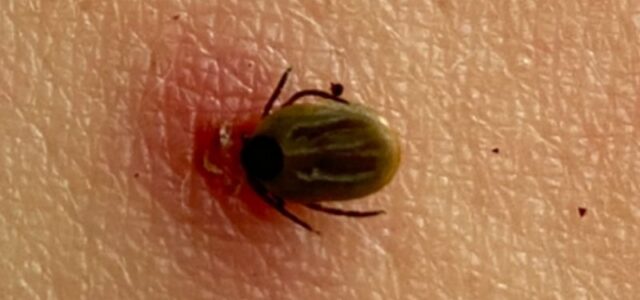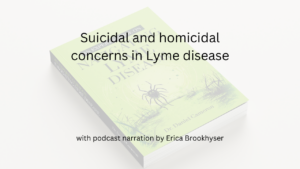Call for your appointment today 914-666-4665 | Mt. Kisco, New York

Welcome to an Inside Lyme case study. I find that the best way to get to know Lyme disease is through reviewing actual cases. I will be discussing how to remove an engorged tick in an eyelid.
Jaroudi and colleagues first discussed this case in the journal Case Reports in Ophthalmology in 2020.
“The patient’s mother reported noticing a small foreign body protruding from her daughter’s eyelid which was increasing gradually in size over the course of 5 days,” writes Jaroudi and colleagues in the journal Case Reports in Ophthalmology.
“A slit-lamp exam revealed a large tick deeply anchored to the right upper eyelid,” writes the authors. The girl had visited an animal farm as part of a school trip a few days earlier.
[bctt tweet=”Case report reviews the best way to remove a tick embedded in an eyelid.” username=”DrDanielCameron”]
The doctors removed the deer tick stuck in the eyelid. “Our surgical approach hereby included total excision of the tick with its attached eyelid,” wrote the authors. The procedure included removing a small portion of the child’s eyelid along with the engorged tick.
The pathologist identified the tick as an Ixodes species, more commonly known as a deer tick.
In an open-access article, the authors posted a clear picture of a hugely engorged tick in the girl’s eyelid. The tick and the girl’s right periorbital swelling and redness with eyelid ptosis are pictured. Ptosis is when the upper eyelid droops over the eye. The case report and pictures are available for free at https://www.ncbi.nlm.nih.gov/pmc/articles/PMC6940453.
The risk of Lyme disease from an engorged tick can be as high as 20% in endemic areas of the USA. The authors stressed the need “to consider antibacterial prophylaxis following tick removal as ticks are blood-sucking ectoparasites and vectors of bacteria, viruses, and rickettsia.”
There was no evidence of Lyme disease or co-infections at the time the tick was removed. The doctors treated the girl prophylactically with oral amoxicillin for 10 days.
The logic behind careful removal of an engorged tick
The authors explain their decision to excise the tick and part of the eyelid. Doctors have been concerned that compressing the body of the tick might also increase the chance the tick might regurgitate toxins and tick-borne pathogens into the wound.
The authors were also concerned that “the hypostome or tick head may stay attached to the host with granuloma formation.”
The authors described the classic way of removal of a deer tick. This includes “Avoiding unnecessary manipulation of the tick, grasping very firmly the tick’s mouthparts as close to the skin as possible, and cleaning the lesion after tick removal.”
The authors describe two additional ways of removal of the tick that doctors have warned might lead to regurgitation of the tick-borne infection into the girl: “applying focal heat to induce release and smothering the tick with petrolatum to induce release.”
What can we learn from these cases?
- Careful removal of a tick is essential.
- Surgical excision of a deer tick can be effective at preventing regurgitation of tick-borne infections and a granuloma formation.
What questions do these cases raise?
- What is the best treatment for a tick bite to prevent an infection? She was treated with ten days of amoxicillin. I am not comfortable with the single 200 mg of doxycycline for a tick bite advised by the Infectious Disease Society of America (IDSA). I typically treat for 3 to 4 weeks with follow-up to be sure I have a good outcome.
- Is the girl at risk of developing a co-infection that cannot be treated with amoxicillin? For example, amoxicillin is not effective for common tick-borne infections such as Ehrlichia, Anaplasmosis, or Babesia.
- Will the girl develop chronic illness from the tick bite? Up to a third of individuals with Lyme disease can become chronically ill.
Treating Tick-Borne Disease
We need to determine the best course of treatment for a tick bite to prevent chronic illness.
Inside Lyme Podcast Series
This Inside Lyme case series will be discussed on my Facebook and made available on podcast and YouTube. As always, it is your likes, comments, and shares that help spread the word about this series and our work. If you can, please leave a review on iTunes or wherever else you get your podcasts.
Sign up for our newsletter to keep up with our cases.
References:
- Jaroudi MO, Mansour AM, Ma’luf R, Meduri A, Tawil A, Younis MH. Large Tick (Ixodes) Infestation of the Upper Eyelid Presenting as Eyelid Mass and Preseptal Cellulitis. Case Rep Ophthalmol. 2019 Nov 28;10(3):403-407.



